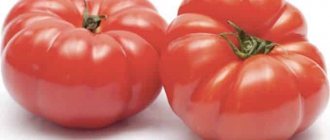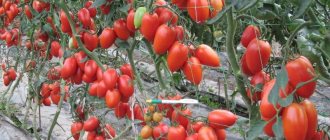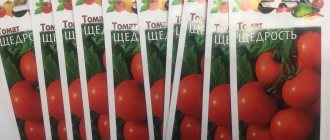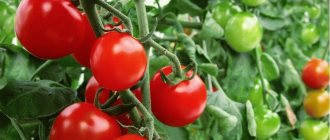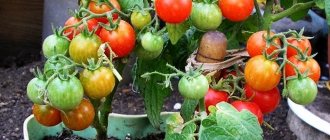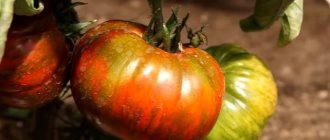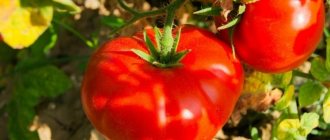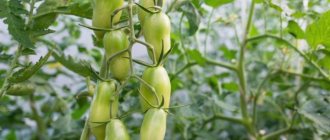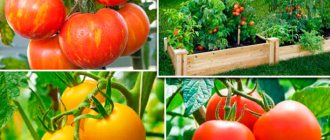Description of the variety
A mid-season and tasty tomato is recommended for growing in greenhouses. The variety loves fertile soil and fertilizers and does not tolerate drought and heat. The ripening period is about 110 days, the tomatoes ripen together.
Alexander the Great is a hybrid, resulting from crossing other varieties. The vegetable has good immunity to diseases and insect pests.
Distinctive features
The bushes of the plant are tall, the average height is about 2 m. During the maintenance process, the stems are tied to supports, since heavy vegetables pull the bushes down to the ground.
The foliage is lush, the color is dark green. For the best harvest, the stems are shaped. In the south of the country, the Alexander the Great variety is also grown in open ground.
Characteristics of tomatoes, yield
Tomatoes are dense, round in shape. At ripeness they have a bright red rich color. On average, the weight of one is about 250 g, with proper care and fertile soil it can reach 0.5 kg.
The skin is dense, so tomatoes are not prone to cracking. The pulp is fleshy, with a large amount of useful microelements and vitamins.
With watering and regular fertilizing, gardeners remove about 5.5-6 kg of ripe tomatoes from 1 bush.
Yield varieties of tomatoes 2021
Varieties that are most often planted in open ground are standard varieties with the shortest possible ripening time. Among them the following stand out:
- Red Fang has elongated tomatoes weighing up to 60 g, but about 3 kg of harvest can be harvested from the bush;
- Gina , which will produce fruits weighing about 200 g, with each bush having a yield of 4 kg;
- Lojain promises slightly larger tomatoes, and a higher yield (8 kg), while it is characterized by increased resistance to drought.
In most of Russia, tomatoes are grown only in greenhouses. Therefore, you also need to know such new varieties of tomatoes for 2021. Gardeners can pay attention to the following names of early tomatoes:
- Tornado F, with proper care, can please gardeners with a harvest of 8 kg;
- Empire F will produce small fruits weighing up to 140 grams in the form of cream;
- Samurai is distinguished by its pink color; a tomato weighing 200 g will produce a yield of about 4 kg;
- De Barao are characterized as tomatoes with fruits weighing 100 g, which yield a yield from a bush of 4 kg;
- Verlioka+ F is characterized as disease resistant;
- Yakimanka F bears fruit with tomatoes weighing about 230 g.
New varieties of tomatoes recommended by breeders
- Watercolor. A variety that will produce a harvest within 100 days. Tomatoes are oval in shape and weigh from 80 to 120 g. Therefore, they are excellent for pickling. The undoubted advantage of these tomatoes is their good transportability and long shelf life.
- Alsou. It is a universal tomato for growing, since it can grow both in open ground and in a greenhouse. In the first case, it will grow 80 cm from the ground, and in a closed greenhouse it will stretch up to 1 m 20 cm. Its tomatoes grow weighing from 600 g to 1 kg. A good yield of tomatoes will allow you to eat plenty of fresh salads. Due to their size, they are not suitable for canning.
- Dimensionless. The name speaks for itself: its fruits weigh from 1 kg. It can be grown in open beds and greenhouses. The advantage of a tomato is its ability to sit for a long time. Moreover, the fruits do not crack when ripe.
How to grow seedlings
Seedlings are prepared 60-65 days before planting in the garden. Seeds are purchased at the store. When purchasing, carefully read the manufacturer's information. Trust only trusted suppliers with a good reputation.
Seed preparation
Before planting, it is necessary to inspect the seeds for external deviations. If everything is in order, start hardening them. This procedure will improve the immunity of the future plant to sudden changes in climatic conditions. This is especially true for those who plant the variety in open ground.
To harden, place the seeds in the freezer for 10 hours, then remove and leave in the room for a day. Repeat these steps 3-4 times and you can be sure that Alexander the Great will not be “scared” by frosts and strong winds.
Then start germinating the seed. With its help, you will find out the percentage of seed germination and get quick shoots. If the seeds are of poor quality, you will have the opportunity to change them, thereby avoiding failure in the future. For germination it is better to use settled water. Never germinate seeds in cold tap water.
The seeds are soaked in water, and then a slightly damp cloth is placed between them. Change the water several times a day. It is important not to allow it to dry out or become waterlogged. The fabric is placed in a plastic bag or on wet cotton wool. It will protect the material from drying out.
Important ! To stimulate growth, special preparations are added to the water. For example, “Zircon” or “Viohumus”. The products will not only accelerate the appearance of the first shoots, but will also protect the plant from negative factors. For folk remedies, use aloe juice or wood ash.
Container and soil
Experienced gardeners recommend planting seedlings in plastic cassettes. They are small containers fastened together with drainage holes. They come in different lengths and widths, so it’s easy to choose a cassette specifically for your window sill.
Cassettes are easy to use, inexpensive and last a long time. They are lightweight and when planting seedlings in the ground, you can easily remove seedlings from the cassettes. The downside is that in most stores they are sold without pallets - you will have to make them yourself.
For seedlings, use your own soil or soil from the store. To prepare the soil yourself, you will need:
- soil from the garden;
- peat;
- humus;
- wood ash;
- eggshell.
Remember that the soil must be balanced and nutritious. In addition, only loose and light soil is suitable for seedlings - this way the plant will receive the right amount of oxygen. The soil should absorb moisture well and retain it. Its microflora is also important. Under no circumstances should there be weeds or debris, larvae or insects in the ground.
Landing
Pre-prepared soil is poured into clean and dry containers. Next, make holes in it and place a seed in each. Sprinkle a small amount of earth on top and pat down. Don't forget to water the seedlings with warm, settled water.
Immediately after sowing, write the name of the crop and the date on a plastic cassette. Marking will help you remember the name of the variety, as well as monitor how certain seedlings behave.
Growing and care
An important condition for growing seedlings is adequate lighting. Ideally, the plant should be exposed to sunlight for about 14 hours a day .
If daylight hours are shorter in your region, use additional lighting lamps. Remember to periodically turn the seedling trays over so that all the seedlings receive even lighting.
Avoid overwatering the seedlings. It is best to water it with a spray bottle every 7-10 days. It is better to water adult seedlings from a tray - this way the root system will gain strength faster. The air temperature should be at least 20 degrees.
Important ! Containers must have good drainage. Excess or lack of moisture can destroy a young plant. In addition, periodically loosen the soil. Hard soil slows down the flow of oxygen to the sprouts.
Feed the seedlings early in the morning on a cool day. The first feeding coincides with the appearance of the first shoots. Use preparations containing nitrogen, phosphorus and potassium. The most popular means are urea, nitroammophoska, ammonium sulfate. They promote protein formation and chlorophyll production. For seedlings, fertilizers in liquid form have the greatest effect.
Growing and care
Experienced summer residents recommend sterilizing the seeds in a potassium permanganate solution before planting them in the ground, and then dipping the seed into a growth stimulator. They explain this by the fact that this way the seeds will germinate faster and the germination rate will be almost 100%. It is not advisable to pick this type of tomato; it is better to immediately plant the seed in disposable cups so that it initially gains strength, without subsequent stressful situations.
The appearance of the first shoots has a positive effect on the gardener’s mood; now all that remains is to grow good seedlings and plant them in the greenhouse. The film has been removed from the cups, now the plant can breathe and enjoy the sunlight. Move the contents with the seedlings to the window so that the rays of the sun saturate the soil and nourish the stems with their light. The plant needs watering with warm water; repeat this procedure as the soil dries out. It would be a good idea to feed the bushes with mineral supplements once every two weeks.
Summer is approaching, it's time to transplant the seedlings into the greenhouse. It is usually recommended to plant no more than three bushes per square meter. Otherwise, the plant will grow and the leaves will interfere with each other. Don’t forget to immediately prepare a support to which you will later tie the stem. The fruits will become larger and fleshier if the shoots are planted over time. Twice during the summer, feed your vegetables with potassium and phosphorus. Harvest the ripe crop on time so that the top tomatoes do not decrease in volume.
Attention!
The Catherine the Great tomato is intended for growing in unheated and heated greenhouses.
How to grow tomatoes
To plant seedlings, you need to prepare the beds. In the fall they are dug up, garbage and weeds are burned. In spring, fertilize with a mixture of manure and leaves.
Landing
For planting, choose a calm and cloudy day. Harden off the seedlings 1 week before planting. To do this, take her out to the balcony every night, daily increasing the period of her stay in the open air. It is recommended to place bushes at a distance of 40-50 cm from each other.
Then pour in plenty of warm water. Try to ensure that moisture does not fall on the stem and leaves, but goes directly to the root. The next watering is in a week.
Growing and care
Gardeners recommend:
- Water the tomatoes in the evening or in the morning. To do this, use water at room temperature.
- Loosen the soil every 10 days . If you see that a hard crust forms more often, then reduce the loosening interval and carry out the procedure every 5-7 days.
- Remove weeds as they appear. She lives off the nutrients of the tomato, taking away its strength for further development.
- Tie the stems to the support. To do this, use wooden pegs and twine. Don't tie the knots too tightly - the bushes may break.
- Remove stepsons. They, like weeds, take nutrition from tomatoes. It is recommended to remove shoots every 8-10 days.
- Remember about fertilizing. Throughout the entire growing period, they are organized every 15 days. Use both mineral and organic fertilizers. For example, mother solution A, garlic tincture, liquid mullein, ammonium nitrate, wood ash solution.
Features of cultivation and possible difficulties
Difficulties can arise with an excess or lack of nutrients. A lack of nitrogen leads to changes in leaf color. They acquire a yellow or straw tint and begin to dry out. In addition, the tomatoes themselves become hard and their growth slows down.
If there is not enough phosphorus, the leaves curl. Lack of potassium causes curling of young leaves and wilting of old ones.
Sulfur starvation is also common in garden beds. At first, the leaves acquire a light green color, and then sharply turn yellow or red. Sulfur starvation makes the plant dry and brittle.
To saturate tomatoes with nitrogen, use special preparations. To solve the problem, potassium nitrate, magnesium sulfate, calcium sulfate, and boric acid are suitable. The dosage depends on what specific substances the tomatoes lack.
Diseases and pests
Tomato Alexander the Great can occasionally suffer from late blight. No variety is immune from this fungus. Appears in the form of yellow spots and white plaque. The spore penetrates the stem and infects the entire bush. It is almost impossible to get rid of late blight. The development of blackleg is possible - a disease of the roots, as a result of which metabolism is disrupted and the bushes die.
Of the pests, aphids and whiteflies are especially dangerous for tomatoes. The insects are very similar to each other, they look like a small white moth.
It is almost impossible to see them with the naked eye. They land in flocks on the leaves and eat the bush. The crop is also susceptible to spider mites. The insect leaves its web on the stem and leaves, which causes a lack of nutrition.
In order not to deal with insects and pests after they appear, it is better to immediately carry out prevention. To do this, it is recommended to periodically treat the beds with a solution of wood ash or garlic water.
Spraying the bushes with whey or a solution based on tobacco leaves is also considered a good remedy against pests. Organic procedures are absolutely safe for both vegetables and humans.
Great tomatoes - Ekaterina, Vladimir and Alexander, reviews, photos, productivity - all about tomatoes
Summer residents ask how to grow the Catherine the Great f1 tomato, reviews of which they saw on forums on the Internet.
In specialized stores, various varieties of tomatoes are now offered for sale, striking the imagination with their names.
These can be the names of fruits (Yellow Banana), and professions (Hairdresser), and cities (Volgograd), and names of animals (Tambov Wolf), and names (Lyubasha, Katya).
- 1 Description of the variety Ekaterina Velikaya
- 2 Reviews from gardeners
There are even “royal” varieties, among which the most popular are: King of Early, King of Kings, King of Giants, King of Large, Pink King.
It is possible to purchase “Imperial” and “Princely” varieties, another name for which is “Great”: Catherine the Great, tomato Vladimir the Great f1, tomato Alexander the Great.
Let’s take a closer look at the Ekaterina Velikaya f1 tomatoes, consider the main characteristics of the variety and study the reviews of summer residents who grew this variety of tomatoes on their plots.
Description of the variety Catherine the Great
Characteristics and description of the variety:
- The seeds of this variety of tomatoes are produced by one of the leading companies engaged in the production and sale of seeds of various garden crops.
- Tomatoes belong to the mid-early varieties. Harvesting the first harvest can begin 3.5-4 months after sowing the seeds.
- The variety is quite tall: the average plant height is 2 m, and some specimens can grow up to 2.5 m, which requires repeated tying to plant supports, as well as timely pinching in order to increase the yield of the bushes.
- The fruits hang in clusters of about 5-6 pieces each.
- The fruits are round in shape with a fairly dense skin, juicy and fleshy pulp.
- The structure of the skin does not allow the fruits to crack even in an overripe state, so tomatoes tolerate transportation over long distances and long-term fresh storage.
- The color of the tomatoes is scarlet.
- The weight of each fruit is about 250-500 g.
- With a planting pattern of 50x40 cm, from 1 m² it is possible to collect about 25-30 kg of sweet tomatoes, suitable for fresh consumption, salads, making ketchups, juices, pastes and various sauces.
The variety in question is only suitable for growing in greenhouse conditions, and it is preferable if the greenhouses are heated.
The seeds undergo high-quality treatment at the plant against diseases, so tomatoes are not afraid of diseases such as verticillium, brown spot, and mosaic disease.
Advantages of the variety:
- average academic performance;
- large-fruited, which persists throughout the entire fruiting period;
- high productivity;
- tolerate sudden temperature changes well;
- suitable for long-term storage and transportation;
- resistance to most diseases that affect tomatoes.
Despite such good positive aspects that the Ekaterina Velikaya variety has, it also has a number of significant disadvantages that do not allow it to be in good demand among summer residents:
- this variety is a hybrid, so it makes no sense to harvest seeds yourself - some of the properties from the mother bushes cannot be preserved;
- the maximum yield can be obtained if you grow tomatoes of this variety in greenhouses, and in heated ones;
- additional tying up of plants is required due to their very significant height;
- the fruits are not suitable for whole-fruit pickling and pickling.
Reviews from gardeners
Let's consider the reviews of those who planted tomatoes of the variety in question on their plot.
Due to a number of features and disadvantages of the variety, Ekaterina Velikaya tomatoes are not very popular among gardeners, so the number of summer residents who planted these tomatoes is not growing as actively as they would like every year. This is what gardeners say about the results of their work growing these tomatoes.
Inna Dmitrievna, Moscow:
“I was looking for new varieties of tomatoes for myself and came across this one. The picture showed very beautiful tomatoes. I decided to try growing it. I liked everything, especially the taste.
The only thing is that the manufacturer indicated on the package of seeds that the size of the fruits is approximately the same throughout the entire fruiting period.
It didn’t work out that way for us: there were some especially large fruits, weighing 300-350 g, but there were also 2 times less.”
Evgeniy Alexandrovich, Perm region:
“The tomatoes are very tasty, but they are very tall, so I will be looking for an alternative.”
Marina Vitalievna, Saratov:
“We planted this variety of tomatoes for the first time last season. We have a greenhouse, but it is unheated. The fruits turned out to be of different sizes, but very tasty. From 5 bushes we managed to collect about 18 kg of harvest. This is a record for us."
Source:
The nuances of growing in open ground and in a greenhouse
When growing tomatoes in open ground, use a drip irrigation system. The advantages of the method are that water enters the beds gradually and does not cause sharp fluctuations in soil moisture. In addition, water does not stagnate on the surface of the earth, which means that the risk of fungal diseases and infections is reduced.
If the tomato is planted in a greenhouse, monitor the humidity and temperature levels. Greenhouses are characterized by stuffiness and heat, so do not forget to ventilate the structure. Also, during preventive treatments of bushes against diseases, pay attention to walls and other hard surfaces. They can also contain germs.
Features of growing tomatoes Alexander the Great, planting and care
Sowing seeds for seedlings is carried out 60-65 days before the intended planting in the ground. Seedlings dive at the stage of two true leaves. When planting seedlings in a permanent place per 1 sq. It is recommended to place up to 3 plants per meter of land, and up to 4 when formed into 1 stem.
Further care for tomatoes consists of timely watering, fertilizing with complex mineral fertilizer, pinching and preventive measures to protect against diseases and pests.
When growing tomatoes in a greenhouse, we recommend installing a drip irrigation system - this will save your time and effort, as well as increase plant productivity and reduce the risk of late blight.
If you grew Alexander the Great tomatoes, please write whether you liked them or not. What was the yield and taste of the fruits like under your climatic conditions? How do you rate the disease resistance of this tomato variety? Briefly describe the advantages and disadvantages of this tomato in your opinion. If possible, attach a photo of your tomatoes to your comment. Thank you!
Your reviews of the Alexander the Great tomato and additions to the description will help many gardeners evaluate this variety more objectively and decide whether it is worth planting or not.
Harvesting and application
At the ripe stage, vegetables need to be harvested daily. Pick tomatoes that are pink in color, as red ones speed up the ripening of the bunch. It is better to pick tomatoes without stalks.
The Alexander the Great variety is used in cooking, folk medicine, and cosmetology. The vegetable is ideal for preparing salads, side dishes, and cold appetizers.
In addition, a medicinal tincture is made from it. The drug helps get rid of colds and strengthen the immune system during the cold season .
Moreover, tomatoes are a natural antidepressant and should be eaten when a person is in a bad mood.
Farmer reviews
This is what gardeners say in their online reviews about the Alexander the Great variety.
Elvira, Tyumen: “Last year I planted 3 beds of Alexander the Great f1. The variety is very worthy. The summer was cold, but the harvest was still a success. For growth I used mainly organic fertilizers. I grew it in a greenhouse."
Maria, Voronezh region: “In my opinion, the variety combines all the best - color and taste. The tomatoes started growing quickly and there were no problems with growing them. The return turned out to be friendly. We ate it fresh, made tomato juice and preserved it for the winter.”
Tatiana. Kurgan region: “The variety was recommended to me for a long time, and finally I planted it. I expected more. The taste is good, but it took a lot of care. In my opinion, this should not be typical for a hybrid.”

